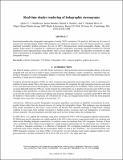Real-time shader rendering of holographic stereograms
Author(s)
Smalley, Daniel E.; Barabas, James D.; Smithwick, Quinn Y. J.; Bove, V. Michael, Jr.
DownloadSmithwick-2009-Real-time shader rendering of holographic stereograms.pdf (1.273Mb)
PUBLISHER_POLICY
Publisher Policy
Article is made available in accordance with the publisher's policy and may be subject to US copyright law. Please refer to the publisher's site for terms of use.
Terms of use
Metadata
Show full item recordAbstract
Horizontal-parallax-only holographic stereograms of nearly SDTV resolution (336 pixels by 440 lines by 96 views) of textured and normal-mapped models (500 polygons) are rendered at interactive rates (10 frames/second) on a single dual-head commodity graphics processor for use on MIT's third-generation electro-holographic display. The holographic fringe pattern is computed by a diffraction specific holographic stereogram algorithm designed for efficient parallelized vector implementation using OpenGL and Cg vertex/fragment shaders. The algorithm concentrates on lightfield reconstruction by holographic fringes rather than the computation of the interferometric process of creating the holographic fringes.
Date issued
2009-02Department
Massachusetts Institute of Technology. Media LaboratoryJournal
Proceedings of SPIE--the International Society for Optical Engineering
Publisher
Society of Photo-Optical Instrumentation Engineers
Citation
Smithwick, Quinn Y. J. et al. “Real-time shader rendering of holographic stereograms.” Practical Holography XXIII: Materials and Applications. Ed. Hans I. Bjelkhagen & Raymond K. Kostuk. San Jose, CA, USA: SPIE, 2009. 723302-12. © 2009 SPIE
Version: Final published version
ISSN
0277-786X